Jihang Wang
PandaGuard: Systematic Evaluation of LLM Safety against Jailbreaking Attacks
May 22, 2025Abstract:Large language models (LLMs) have achieved remarkable capabilities but remain vulnerable to adversarial prompts known as jailbreaks, which can bypass safety alignment and elicit harmful outputs. Despite growing efforts in LLM safety research, existing evaluations are often fragmented, focused on isolated attack or defense techniques, and lack systematic, reproducible analysis. In this work, we introduce PandaGuard, a unified and modular framework that models LLM jailbreak safety as a multi-agent system comprising attackers, defenders, and judges. Our framework implements 19 attack methods and 12 defense mechanisms, along with multiple judgment strategies, all within a flexible plugin architecture supporting diverse LLM interfaces, multiple interaction modes, and configuration-driven experimentation that enhances reproducibility and practical deployment. Built on this framework, we develop PandaBench, a comprehensive benchmark that evaluates the interactions between these attack/defense methods across 49 LLMs and various judgment approaches, requiring over 3 billion tokens to execute. Our extensive evaluation reveals key insights into model vulnerabilities, defense cost-performance trade-offs, and judge consistency. We find that no single defense is optimal across all dimensions and that judge disagreement introduces nontrivial variance in safety assessments. We release the code, configurations, and evaluation results to support transparent and reproducible research in LLM safety.
Neuro-Vision to Language: Image Reconstruction and Language enabled Interaction via Brain Recordings
May 01, 2024



Abstract:Decoding non-invasive brain recordings is crucial for advancing our understanding of human cognition, yet faces challenges from individual differences and complex neural signal representations. Traditional methods require custom models and extensive trials, and lack interpretability in visual reconstruction tasks. Our framework integrating integrates 3D brain structures with visual semantics by Vision Transformer 3D. The unified feature extractor aligns fMRI features with multiple levels of visual embeddings efficiently, removing the need for individual-specific models and allowing extraction from single-trial data. This extractor consolidates multi-level visual features into one network, simplifying integration with Large Language Models (LLMs). Additionally, we have enhanced the fMRI dataset with various fMRI-image related textual data to support multimodal large model development. The integration with LLMs enhances decoding capabilities, enabling tasks like brain captioning, question-answering, detailed descriptions, complex reasoning, and visual reconstruction. Our approach not only shows superior performance across these tasks but also precisely identifies and manipulates language-based concepts within brain signals, enhancing interpretability and providing deeper neural process insights. These advances significantly broaden non-invasive brain decoding applicability in neuroscience and human-computer interaction, setting the stage for advanced brain-computer interfaces and cognitive models.
Brain-inspired and Self-based Artificial Intelligence
Feb 29, 2024



Abstract:The question "Can machines think?" and the Turing Test to assess whether machines could achieve human-level intelligence is one of the roots of AI. With the philosophical argument "I think, therefore I am", this paper challenge the idea of a "thinking machine" supported by current AIs since there is no sense of self in them. Current artificial intelligence is only seemingly intelligent information processing and does not truly understand or be subjectively aware of oneself and perceive the world with the self as human intelligence does. In this paper, we introduce a Brain-inspired and Self-based Artificial Intelligence (BriSe AI) paradigm. This BriSe AI paradigm is dedicated to coordinating various cognitive functions and learning strategies in a self-organized manner to build human-level AI models and robotic applications. Specifically, BriSe AI emphasizes the crucial role of the Self in shaping the future AI, rooted with a practical hierarchical Self framework, including Perception and Learning, Bodily Self, Autonomous Self, Social Self, and Conceptual Self. The hierarchical framework of the Self highlights self-based environment perception, self-bodily modeling, autonomous interaction with the environment, social interaction and collaboration with others, and even more abstract understanding of the Self. Furthermore, the positive mutual promotion and support among multiple levels of Self, as well as between Self and learning, enhance the BriSe AI's conscious understanding of information and flexible adaptation to complex environments, serving as a driving force propelling BriSe AI towards real Artificial General Intelligence.
DPSNN: A Differentially Private Spiking Neural Network
May 24, 2022



Abstract:Privacy-preserving is a key problem for the machine learning algorithm. Spiking neural network (SNN) plays an important role in many domains, such as image classification, object detection, and speech recognition, but the study on the privacy protection of SNN is urgently needed. This study combines the differential privacy (DP) algorithm and SNN and proposes differentially private spiking neural network (DPSNN). DP injects noise into the gradient, and SNN transmits information in discrete spike trains so that our differentially private SNN can maintain strong privacy protection while still ensuring high accuracy. We conducted experiments on MNIST, Fashion-MNIST, and the face recognition dataset Extended YaleB. When the privacy protection is improved, the accuracy of the artificial neural network(ANN) drops significantly, but our algorithm shows little change in performance. Meanwhile, we analyzed different factors that affect the privacy protection of SNN. Firstly, the less precise the surrogate gradient is, the better the privacy protection of the SNN. Secondly, the Integrate-And-Fire (IF) neurons perform better than leaky Integrate-And-Fire (LIF) neurons. Thirdly, a large time window contributes more to privacy protection and performance.
Spiking CapsNet: A Spiking Neural Network With A Biologically Plausible Routing Rule Between Capsules
Nov 15, 2021



Abstract:Spiking neural network (SNN) has attracted much attention due to their powerful spatio-temporal information representation ability. Capsule Neural Network (CapsNet) does well in assembling and coupling features at different levels. Here, we propose Spiking CapsNet by introducing the capsules into the modelling of spiking neural networks. In addition, we propose a more biologically plausible Spike Timing Dependent Plasticity routing mechanism. By fully considering the spatio-temporal relationship between the low-level spiking capsules and the high-level spiking capsules, the coupling ability between them is further improved. We have verified experiments on the MNIST and FashionMNIST datasets. Compared with other excellent SNN models, our algorithm still achieves high performance. Our Spiking CapsNet fully combines the strengthens of SNN and CapsNet, and shows strong robustness to noise and affine transformation. By adding different Salt-Pepper and Gaussian noise to the test dataset, the experimental results demonstrate that our Spiking CapsNet shows a more robust performance when there is more noise, while the artificial neural network can not correctly clarify. As well, our Spiking CapsNet shows strong generalization to affine transformation on the AffNIST dataset.
 Add to Chrome
Add to Chrome Add to Firefox
Add to Firefox Add to Edge
Add to Edge